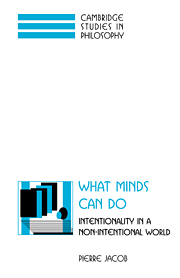Book contents
- Frontmatter
- Contents
- Acknowledgments
- Introduction
- PART I THE NATURALIZATION OF INTENTIONALITY
- PART II THE CAUSAL ROLE OF INTENTIONALITY
- 5 The computational representational theory of mind (CRTM)
- 6 Must an intentional realist be a meaning atomist?
- 7 Functionalism and the threat of preemption
- 8 Explaining intentional behavior
- 9 Conclusion: a postlude on semantics and psychology
- References
- Index
5 - The computational representational theory of mind (CRTM)
Published online by Cambridge University Press: 09 November 2009
- Frontmatter
- Contents
- Acknowledgments
- Introduction
- PART I THE NATURALIZATION OF INTENTIONALITY
- PART II THE CAUSAL ROLE OF INTENTIONALITY
- 5 The computational representational theory of mind (CRTM)
- 6 Must an intentional realist be a meaning atomist?
- 7 Functionalism and the threat of preemption
- 8 Explaining intentional behavior
- 9 Conclusion: a postlude on semantics and psychology
- References
- Index
Summary
A TWOFOLD VIEW OF THE MIND
Let us take stock. In chapter 1, I referred to what I called the dilemma of the intentional realist. On the one hand, the intentional realist is a physicalist: a mind must be nothing but a complex physical system among many. So one horn of the dilemma is that the intentional realist is a reductionist about the mind. On the other hand, the intentional realist is a realist about the mind. So – and this is the other horn of the dilemma – the intentional realist is anti-reductionist about the mind: minds must be unique (or uniquely organized) physical systems.
Because he is gripped by the naturalistic perplexity, the intentional realist wants to bridge the gap between the mental or the semantic and the non-semantic. Even if he is a token physicalist, he would be deeply unhappy if “the semantic” were to “prove permanently recalcitrant to integration in the natural order.” He cannot tolerate what Field (1972) labelled semanticalism on the model of vitalism, i.e., he cannot tolerate that semantic facts be primitive facts. So in this sense, he is after some kind of a reduction of the mental to the non-mental. Because he is a reductionist about the mental, the intentional realist must, in Fodor's (1987a) words, show that “intentionality is not a fundamental feature of the world … or … [show] how an entirely physical system could nevertheless exhibit intentional states.”
- Type
- Chapter
- Information
- What Minds Can DoIntentionality in a Non-Intentional World, pp. 141 - 173Publisher: Cambridge University PressPrint publication year: 1997



